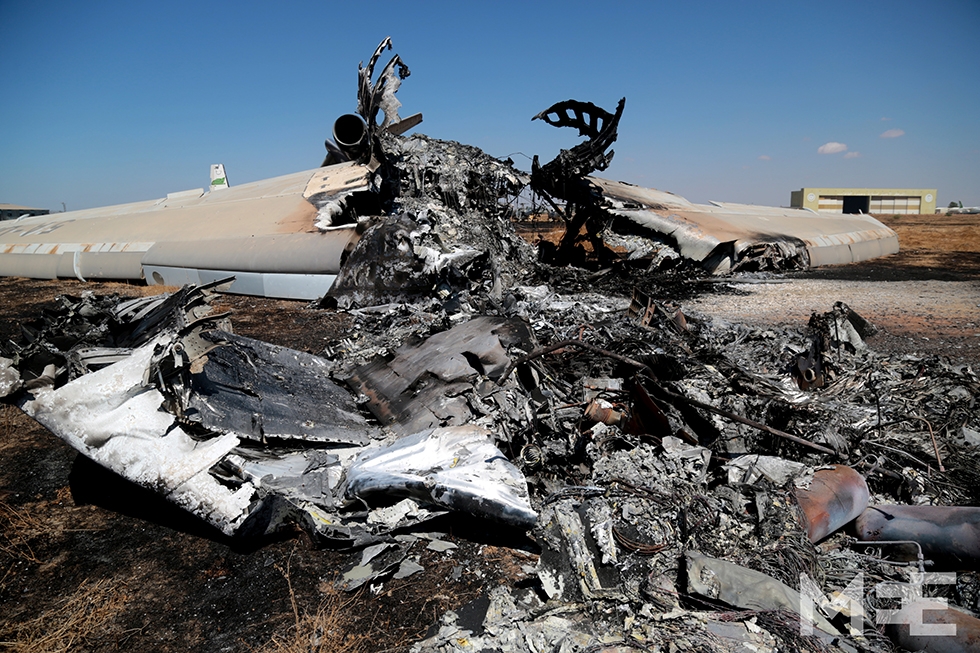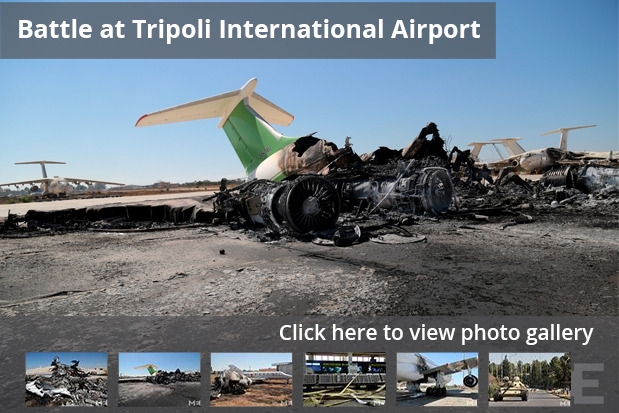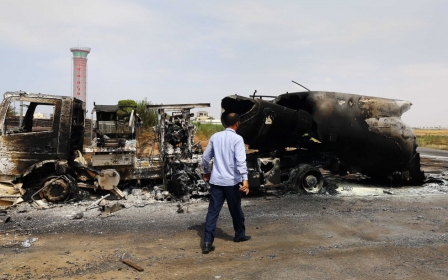Once they were heroes in Libya

A gaping hole in the ceiling where rockets, mortars and anti-aircraft bullets had fallen, glass doors shattered by the shock of detentions, armed men patrolling the departure lounges; this is the reality of Tripoli International airport, a place that only a week ago buzzed with life as the country’s main bridge to the outside world. Now that airport lies wrecked, the planes smashed like giant toys and smoke covering the horizon south-west of Tripoli.
Many of the militias that exist in Libya today fought together in 2011, with the help of the international community, to oust dictator Muammar Gaddafi, who had ruled Libya for 42 years. But thus far all attempts by Libya’s governments to legitimise these rebel soldiers, once seen as heroes, into what would be Libya’s national army have failed.
On Sunday 13 July, rival militia groups from two towns that rose to prominence for their courage and fierce fighting in the 2011 revolution began a turf war that has continued for the past week, the turf they fight over is Tripoli’s main international airport – this has now been reduced to a battlefield strewn with plane wrecks.
Battles and street wars break out quite often in Libya’s capital, but generally end as fast as they start. However, the latest battle for power has been unique in its ferocity and the amount of damage it has caused, increasing concerns that the country could descend into an all out civil war.
Both of the militias involved in the battle are under state payrolls and are both registered as official forces of the Libyan army.
Reckless actions
Misrata, a city that played an important role in the uprising against Gaddafi, is home to Libya Shield, the largest single force in Libya. “We have around 1,000 anti-aircraft machine-gun mounted trucks, and up to 7,000 men,” says Abubaker Alhuta, head of operations at Libya Shield’s Tripoli barracks.
The barracks are an old neglected Gaddafi-era military base in Tripoli’s southern district of Salah Edeen. It used to be an artillery and rockets military academy. A couple of large rockets destroyed by the Nato bombardment lie in exactly the same place as they did three years ago.
Abubaker blames the death of a friend on the reckless actions of Salah Badi, a former member of Libya’s transitionary parliament and commander of a Misrata militia. “Badi’s attack was stupid and irresponsible, we lost good young men because of his actions,” he says, as we walk through the dusty barracks.
“From the very beginning Samir was with me when liberating Misrata, Tripoli, Sirte and Bani Walid, and he died on Monday because of Badi. He didn’t even want to be there.”
The militias the Misratans have been fighting come from Zintan, a mountain town situated roughly 140km southwest of Tripoli.
“We were close to reaching an agreement with them [the Zintan militias] now after the attack, how can we expect them to trust us again if we try to initiate new talks?”
Abubaker and his friend Samir weren’t the only fighters who had reservations about the attack on the airport, but no one disobeyed orders according to Abubaker. “What can we do? We are Misratan! Badi is one of us,” he says.
The attack by the Misrata militias under the command of Salah Badi came as a shock to many, including the men he was attacking. “We held peace talks with them, and almost reached an agreement. The next thing we knew they were firing rockets at us,” says Abdulmenam, a Zintan militiaman who is based at the airport.
He says they’ve been coming under regular attacks from Grad missiles and anti-aircraft guns. “Every night at sunset it begins,” he says. “Yesterday we lost two men.”
Zintan was largely unheard of until the 2011 uprising when its fighters held one of three main frontlines against Gaddafi’s forces and captured his son Saif al-Islam. Saif remains imprisoned by the town’s militias in a secret jail located in the mountains around Zintan, despite pleas from human rights organisations who want to see him tried in the Hague.
Since the revolution, Zintan militias have controlled the airport as well as the Airport Road, a motorway that connects the airport with Tripoli. Driving down to meet Abdulmenam, the only cars on the motorway were those of Zintan militiamen. At the last checkpoint before the airport heavily armed young men sat in the back of pickup trucks and on a tank with the words “Lions of Zintan” painted on it. As I approached, they jumped down and drove me into the airport where another tank stood squarely in the middle of the main entrance.
“It’s not about us, they want to destroy the airport,” says Abdulmenam, as he exhibited casing from a Grad missile that had landed in the main terminal that morning (Thursday). Dust was everywhere and pieces of shrapnel from the missile were scattered all over the terminal’s floor, as the men carried out boxes of cash from the wreckage of a Western Union bank. “We’ll keep this safe until the airport reopens,” says one of the militiamen carrying the boxes.
“The Misratans don’t know who they’re messing with, but even then they are afraid. If they want a fight, come and fight. Don’t hide between civilians so we can’t get to you and fire at us from miles away,” says Abdulmenam.
Every plane at the airport had at least one scar where it had been hit either with an anti-aircraft bullet or mortar round. Some of them had nothing left but a pair of wings. One of the many aircrafts hit was a new airbus A330 that Libyan Arab airlines waited seven years to receive.
Misratan forces were still firing as we drove across the runway. With the sound of bullets falling not far from where we were, Abdulmenam says, “I wonder if they’ll hit me this time, they’re not very good at aiming.” For seven consecutive days the Misratans, along with local militias from Tripoli, have bombarded the airport.
“We have controlled and protected this airport since 2011 when we liberated it from Gaddafi’s forces,” says Abdulmenam, “and now they are destroying it.”
Caught in the crossfire
For Misratans, though, the presence of Zintan militias at the airport is a problem. “Zintan must leave the airport,” said Anwar Suwan, a member of Misrata’s military council on Sunday, a week after the first attacks, from a small farm in Gaser Bengashir, a district in Tripoli east of the airport, where Misrata are basing their attack.
The Gaser Bengashir district has borne the brunt of this militia war. Houses, cars and even a private clinic were hit in the crossfire. Suwan had come from Misrata to see for himself what was going on, and with the sounds of bombing and gunfire, and the suffocating smell of smoke hanging in the air, he says “they are not official forces, they are militias who steal and they have to go”.
“We didn’t want it to be this way, but today (Sunday) Misrata’s forces will attack” he adds.
Soon after our conversation, the farm we were in came under attack. The Misrata militiamen quickly rushed to the front gate to counter this attack with AKs and anti-aircraft machine guns. We rushed into a car and left from a back entrance, heading to safety further east.
In Tripoli protests broke out over the week in a number of districts because of what some saw as indiscriminate bombardment of their airport. At a protest in Martyrs’ Square, in the heart of Tripoli, the anti-Misrata and anti-militia chants began under the burning Libyan sun. Taking a break from shouting “No to militias and the Libyan Shield”, Mohamed Altbib, a 53-year-old man from Tripoli, said: “This has to stop, the Misrata militias are wrong to do what they are doing. Zintan have been at the airport for three years. Yes, that’s bad! But, how is setting it on fire any better?”
“And the problem is some of Tripoli’s men are fighting alongside them [Misrata],” he added.
Some of the chants at these protests are in support of Benghazi, Libya’s second largest population and the main city in east Libya. Protesters chanted, “Our souls and blood we sacrifice for you Benghazi.”
Benghazi was where the uprising began in 2011 and has been the scene of most of the post-revolutionary unrest, Islamist militias kidnapping and assassinating what remains of Libya’s fragile army is on a daily basis.
Battles have been raging in Benghazi over the last two months between these Islamist militias and Asaykia (thunderbolt), a special forces unit in the Libyan army.
But with very little backing from the state, they can barely contain Ansar Sharia, a radical Islamist militia thought to be responsible for the attack on the US consulate in 2012 that left US ambassador Chris Stevens and three other US nationals dead.
In the rest of Tripoli the roads are quiet. The majority of petrol stations are closed, as the oil companies were not able to distribute petrol to their stations because of the fighting. Residents are having to drive up to 100 kilometres outside the city to fill up their cars and as many canisters they can.
The security situation in Libya has been deteriorating since 2011, and the power struggle in both Tripoli and Benghazi continues with all sides confident they will be the ones who eventually come out on top.
Middle East Eye propose une couverture et une analyse indépendantes et incomparables du Moyen-Orient, de l’Afrique du Nord et d’autres régions du monde. Pour en savoir plus sur la reprise de ce contenu et les frais qui s’appliquent, veuillez remplir ce formulaire [en anglais]. Pour en savoir plus sur MEE, cliquez ici [en anglais].





